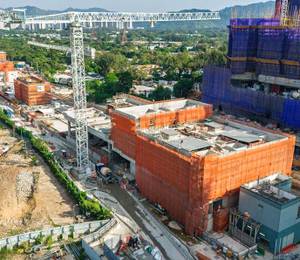The Danjiang Bridge over the Tamsui River on the outskirts of Taipei, Taiwan, is currently under construction. The structure, designed by Zaha Hadid, is expected to be the world’s longest asymmetric cable-stayed bridge upon completion in 2025, at 920 m.
Zaha Hadid won the Danjiang Bridge International Competition back in 2015 for her design of the asymmetrical bridge. When completed, it will connect the Tamsui District in New Taipei City with the Bali District across the river – thus relieving the pressure on other transport routes.
The pylon in the centre of the bridge is a highlight. It towers into the air in the shape of an upturned ‘Y’ and stands, figuratively speaking, with its two legs in the river. The stay cables, which run in parallel to the top of the pylon from both sides, give the structure a futuristic appearance.
Peri was involved in the construction of the pylon by providing, among other things, a custom-designed formwork solution for concreting a total area of 18,000 sq m. To create this futuristic look, Peri developed a freeform formwork system specifically for the project to construct 3,000 sq m of the entire surface.
The complex, ever-changing shape of the pylon, which stretches upwards over 53 sections, posed the biggest challenge. Peri provided its versatile Vario, SCS and ACS systems, which could be individually adapted to the varying geometry.
Customised formwork solutions
Peri systems are characterised by their adaptability to unusual project requirements as well as their compatibility with other Peri products. Using its standard portfolio as a basis, Peri came up with a coordinated, customised solution from a single source for each section of the unique pylon shape.
As such, the Vario GT 24 Girder Wall Formwork provided the ideal foundation for each section of the 200-m-high pylon. After all, this dimensionally stable formwork makes it possible to pour up to 18 m of concrete at a time.
To realise the various shapes and radii of the pylon, Peri Climbing Systems were used alongside formwork solutions. A combination of ACS and SCS was chosen to ensure that processes were quick and efficient. The SCS Climbing System made it possible to construct the inclined design at the upper and lower ends. To help construct the central, straight section, the ACS Self-Climbing System was used, which climbs up the emerging building on rails.
“Since we have been using Peri products, the project has been running smoothly. The efficiency is constantly high so that our requirements regarding the progress of the projects are fully fulfilled,” said Zeng Wei-Cheng, site manager at KSECO.
Peri engineers are also on hand to advise the construction site team throughout the project. From start to finish, the experts provide support with planning and preparation, on-site construction and final completion.
All images: Peri SE
Note: This story has also been published in the Jul/Aug 2024 issue of SEAC (with more images). Click here to read online or here to download the PDF file (pages 42-44).














